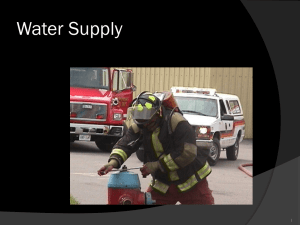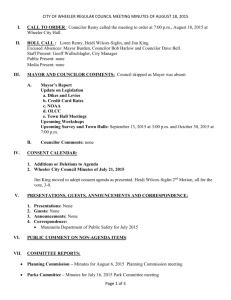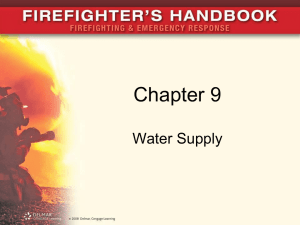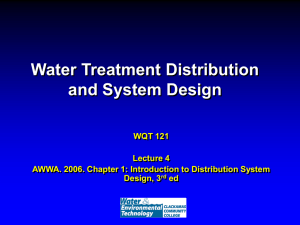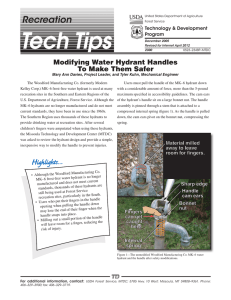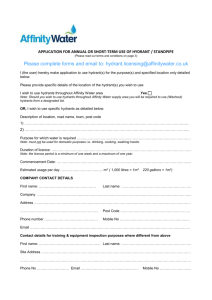PowerPoint
advertisement
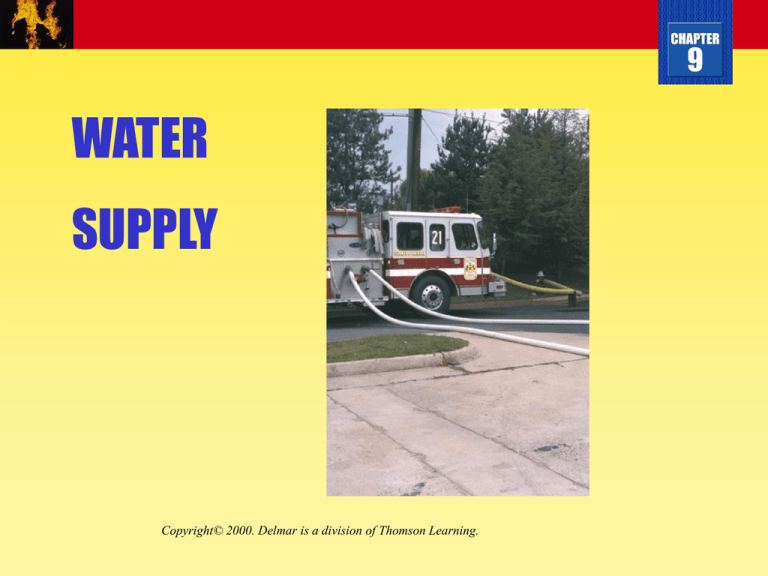
CHAPTER 9 WATER SUPPLY Copyright© 2000. Delmar is a division of Thomson Learning. CHAPTER 9 Objectives 1 of 3 • Explain the value of proper water supply. • Identify sources of water supply for drinking and firefighting. • Explain the difference between ground water and surface water. • Explain the purpose of mobile water supply apparatus. CHAPTER 9 Objectives 2 of 3 • Explain the features of water distribution systems. • Identify types of fire hydrants and their uses. • Identify valves associated with water distribution systems. • Explain how to operate a rural water supply. • Explain a portable water tank operation. • Explain tender operations. CHAPTER 9 Objectives 3 of 3 • Identify the proper pressures associated with water distribution systems. • Conduct a test of the operability and flow of fire hydrants. • Determine the static, residual, and flow pressures of water sources. • Identify the cause of obstructions and damage to fire hydrants and mains. CHAPTER 9 Introduction 1 of 2 • Water supply is one of the most critical elements of firefighting. • Water supply is important in areas with a water distribution system. • Water supply even more important in areas without a water supply system. • Firefighters must know how to establish a water supply. CHAPTER 9 Introduction 2 of 2 • Water source, quantity, and how it is delivered are key questions. • Fire flow capacity is dictated by the water supply. • Fire flow requirement is the amount of water required for putting out the fire. • Water availability will dictate the strategy, tactics, appliances, and fire streams used. CHAPTER 9 Sources of Water Supply • Need to know where water comes from and how it gets from that point to the fire scene. • Many natural and man-made factors affect water sources. • Weather is the greatest factor. • Some areas have abundant water supply while others have none. CHAPTER 9 Groundwater • Most of the earth’s freshwater supply is groundwater. • Groundwater usually results from rain. • Groundwater may collects in pockets called aquifers, and rise as springs. • Water may reach surface through drilling and pumping. • Water must have enough pressure for firefighting. CHAPTER 9 Groundwater Well pump with storage tanks. CHAPTER 9 Surface Water • Surface water is the world’s most common source. • Natural water sources used for firefighting are rivers, lakes, and ponds. • Man-made sources include lakes, ponds, reservoirs, swimming pools, and tanks. • Tidal changes may affect water sources. CHAPTER 9 Surface Water CHAPTER 9 Mobile Water Supply Apparatus • Most engines today have at least a 500 gallon tank. • Tenders have tanks from 1,000 to 8,000 gallons. • Some tenders may have a pump. CHAPTER 9 Tanks, Ponds, and Cisterns • Other developed sources are water tanks, ponds, and cisterns. • Water tanks may be underground, ground level, or elevated. • A cistern can hold large quantities of water (30,000 gallons or more.) • Connections for tanks or cisterns include dry hydrants, drafting pits, or other type. CHAPTER 9 Water Distribution Systems 1 of 2 • Include a method of getting water, treatment processes, storage, supply, and distribution. • Water is supplied by three means: • Gravity fed. • Pumped system. • Combination pumped-gravity system. CHAPTER 9 Water Distribution Systems 2 of 2 • After treatment, water goes into the distribution system. • Water mains are divided into feeders. • Primary feeders divide into secondary feeders and distribution lines. • Good systems are interconnected into loops and grids. CHAPTER 9 Fire Hydrants • There are two major types of hydrants: • Wet barrel. • Dry barrel. • Dry hydrant is a piping system for drafting from a static water source. CHAPTER 9 Wet Barrel Hydrant • Have water in the barrel. • Used in non-freezing temperature areas. • Each outlet controlled by separate valve. CHAPTER 9 Dry Barrel Hydrant • Used in areas that have freezing temperatures. • Valve at base of hydrant controls water flow to all outlets. • Valve should be all the way open or all the way closed. CHAPTER 9 Dry Hydrant • Serves as connection point for drafting. • A pipe system with a pumper suction at one end and a strainer at the other end. • Used primarily in rural areas. CHAPTER 9 Specialty Hydrants • Wall hydrants mounted on side of building for direct connection to water supply system. • Flush-type hydrants. • High-pressure hydrants. CHAPTER Valves Associated with Water Distribution Systems 9 1of 2 • Usually non-indicating type gate valves and check valves found in public water system. • Gate valves are butterfly valves. • Check valves control water flow in one direction. • Backflow preventers are check valves or a pair of check valves. CHAPTER Valves Associated with Water Distributions Systems 9 2 of 2 • Private water valves are of the indicating type such as: • Post indicator valve (PIV). • Wall indicator valve (WIV). • Outside stem and yoke (OS&Y). CHAPTER 9 Rural Water Supply • Rural water supply operation can occur anywhere. • Rural water supply should be understood by all. • Rural water supply operations require careful coordination and control. • Water supply officer should be part of ICS. CHAPTER 9 Portable Water Tanks • Tenders are designed to transport water. • Must be able to quickly drop off water and return to the fill site. • Each tender should have a portable water tank. • Tank usually set up next to attack or supply engine CHAPTER 9 Portable Water Tank CHAPTER 9 Tender Operations • • • • 1 of 3 A tender operation is a shuttle operation. Dump site is where water is delivered. Site should be able to unload multiple tenders. Site should have a turnaround area, operational area, and access to fireground. • Site should allow for safety of personnel. CHAPTER 9 Tender Operations 2 of 3 • Fill site should be properly staffed. • Shuttle operations control fire flow capacity. • Increased efficiency, more tenders, or larger tanks can help increase flow rate. • Increasing vehicle speed will not speed up tender operations. CHAPTER 9 Tender Operations 3 of 3 Fire Flow Rate = Time to fill tender + Time to drop water + Travel time to and from dump site Quantity of Water Carried CHAPTER 9 CHAPTER Pressure Associated with Water Distribution Systems 1 of 2 • • • • All of the earth’s water is under pressure. Seawater is under atmospheric pressure. Drafting takes advantage of atmospheric pressure. Pressure is the force, or weight, of water measured over an area. • Pressure varies according to friction. 9 CHAPTER Pressure Associated with Water Distribution Systems 9 2 of 2 • In the US, average water pressure is 65-80psi. • Pressure greater than 150psi can damage plumbing. • Recommended low residual pressure when pumping from a hydrant is 20 psi. • Fire departments need to know pressures and capacities of water distribution systems. CHAPTER Testing Operability and Flow of Hydrants 9 1 of 3 • Testing should be conducted periodically on fire hydrants. • First tests involve operability of hydrant. • Remove all caps and check threads and gaskets for damage. • Check that valves on the hydrant allow water to flow. CHAPTER Testing Operability and Flow of Hydrants 9 2 of 3 • Check drain valve on dry barrel hydrant • On a dry hydrant, visually inspect piping, caps and gaskets. • Flow test and backflushing of hydrant are last parts of testing dry hydrants. • Flow test should be conducted during normal operations of water supply system. CHAPTER Testing Operability and Flow of Hydrants 9 3 of 3 • One flow test is a fireground method using gauges on the pumper. • Other test is done during planning and requires a Bourdon gauge and Pitot gauges. CHAPTER Determining Static, Residual, and Flow Pressures 9 1 of 3 • Fireground flow testing involves connecting pumper to hydrant and turning it on. • Static pressure is read on the main intake gauge prior to charging lines. • Static pressure is the pressure without any water flowing. • First line is then charged to desired volume. CHAPTER Determining Static, Residual, and Flow Pressures 9 2 of 3 • Once water is flowing, intake gauge is read to get residual pressure. • Second test involves testing multiple hydrants. (Not conducted during fire operations.) • First hydrant is used with the cap gauge to take a static pressure. • Second hydrant is opened and flow measured with a Pitot gauge. CHAPTER Determining Static, Residual, and Flow Pressures 3 of 3 • Process continues until all hydrants are tested. • Next step involves calculation of discharges for hydrants tested. • Formula used: Q = 29.83 cd2 √P 9 CHAPTER 9 Gauges CHAPTER Obstructions and Damage to Fire Hydrants and Mains 9 • Encrustrations and blockage of piping by minerals or organisms can restrict waterflow. • Hydrants also subject to damage by vandals. • Damage from improper actions by firefighters may also occur. • Failing to open or close valves fully or cross threading connections results in damage. CHAPTER 9 WRAP-UP 1 of 2 • Water is most common extinguishing agent. • Must understand relationship between water supplied and amount needed. • Supplying water requires an understanding of the components of a water distribution system. • Distribution systems have valves and hydrants to be operated. CHAPTER 9 WRAP-UP 2 of 2 • Firefighters must be able to use mobile supply apparatus, portable water tanks, and conduct shuttle operations. • Firefighters need to be familiar with testing operability and the flow of hydrants.
